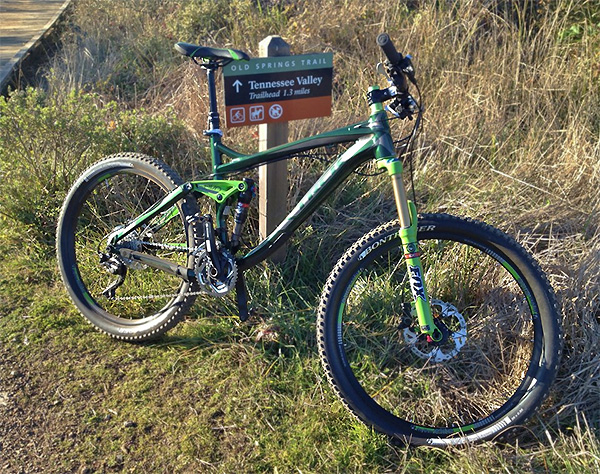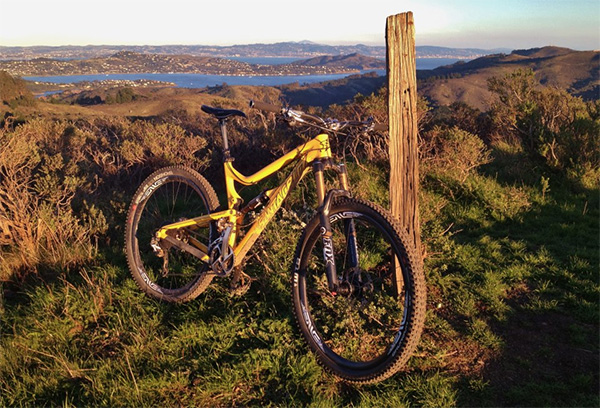How do refined bikes, 10 years in the making, like the 26″ wheeled Trek Remedy, hold up against the likes of a new skool, 29er AM rig, like the Santa Cruz Tallboy LTc? You might be surprised. If nothing else, if you’re in the market for a new mountain bike, make sure you ride a lot of them, and as you narrow your selection down, make sure you do the all important “back to back to back” final rides and selection process. Admittedly, when you have a 26″ wheeled bike compared to a 29″ wheeled bike, it isn’t quite the same type of riding experience… or it it?
The 2013 TRek Remedy Series 9
There’s BIKESKILLS DNA in the Trek Remedy line. Specifically Joe Lawwill, then world cup racer, BIKESKILLS chief instructor, and Trek development rider/engineer, helping Trek to design and develop both their downhill line and trail to all mountain bikes, first called the Trek Liquid. That was back in 2003.
While the first Trek Liquids had issues, they also had lots of promise and where right out of the gate, good bikes. Flash forward to the 2013 Trek Remedy line and you have a complete line of very good bikes that range from about $2K to a wallet destroying $9K.

The quick report on how the Trek Remedy 9 ($4,400) rides is that it’s a stable bike that has one of the better rear suspension designs, but when it comes to stutter and braking bumps and time to slow things down, the Trek’s Active Braking Pivot is simply the best out there – and yes, that includes being better – at least when it comes time to brake – than Santa Cruz’s VPP system.
Beyond the good-to-great rear suspension, which is really the heart of any particular bike brand’s contribution to a complete bike, the Remedy Series 9 has a great parts selection that makes it both a lot of fun to ride, and a bike that will no doubt hold up: complete Shimano XT drivetrain and brakes, Trek/Bontrager wheels, FOX Kashima 150 Float CTD fork, among other bits and pieces. About the only parts we didn’t like all that much were the Bontrager seat and tires. Seats are personal, so whatever on the seat. But the tires while looking good, don’t seem to hook up on much of anything and hard braking results in a case of the squirrels, despite the active braking suspension system.
2013 Santa Cruz Tallboy LTc
At over $10,000, the Tallboy LTc decked out in full XTR and ENVE carbon wheels is about as much money as you can spend on a production mountain bike. And while that’s a lot of money, about 20 times what the average mountain bike sells for in the US, it doesn’t ride that much differently than the $5K XT equipped Tallboy LT – itself just a lighter version, when it comes to ride and handling, to $4K version. In other words, you can spent less than half the ten large, actually a little less than you’d spend on the Trek Remedy 9, and still have more or less the same bike when it comes to what counts.
There’s little point in talking about the pieces and parts on Tallboy LTc XTR/Enve model; other they it represents the best of the best. they’re also components of what magazine after magazine has hailed as one of, if not the best 29er trial bike on the market. We have to agree: it’s that good.
To begin with, getting to the trail head seems easier with those big wheels – but that’s partly because our Tallboy LTc has insanely light and crazy expensive wheels. But even the Tallboys we’ve ridden that have alu wheels, seem to cruise with a little more glide than do our 26: bikes – which includes the Trek Remedy 9.

Headed uphill it seems the same, the Tallboy LTc just sails a little more smoothly. Those larger wheels and tires also seem to be less upset by the occasional rut nor do they seem as prone to losing traction in the loose stuff during a climb.
As things get rougher and the speeds get higher, we’d heard that the Tallboy LTc finds another gear and glides over baby heads and the rough stuff. It does. But it comes with a price, that being that with the longer wheel base and wheels wanting to keep that speed up, hauling it in for a turn out of nowhere, or bending it around tight sections, can be a handful. The Tallboy LTc is one bike you do NOT want to buy a size too large!
So How Do The Remedy 9 and Tallboy LTc Feel on the Same Trails, Back to Back to Back?
We have maybe 20 or so rides on the Tallboy LTc, mostly on the same mix of long fire-road climbs, moderate but fast single track flats and descents as we do on the Remedy 9. That and we’ve purposely gone back and forth on each bike to get a sense of what each bike does better than the other – or at least that was the intent.
What we found is somewhat interesting, and it’s that while there are some big differences in how they feel, compared to one another, you get used to the difference so quickly, that what really comes down to making a decision between good-to-great bikes with different sized wheels becomes a lot tougher than you might think.
While we love the Tallboy LTc’s glide and composure over the kind of trails that you might find at Downville, it’s not like you won’t be able to handle them with the Remedy 9 – you just might spill more of your latte while doing so. Sure, it’s easier to bend the Remedy around switchbacks and tight sections, the kind that a place like Camp Tamarancho is famous for, but within a few rides, you’ll figure the Tallboy LTc out and be slaying switchbacks like Joe Lawwill.
Summary and Recommendations
If you were looking for more help in making a decision when it comes to 26″ v 29″ trail bikes, we were hoping to help, we really were, it’s just hard to do. If we were talking about 26 v 29 for hard tail XC rigs, that’s a no brainer: 29ers all the way.
The good news here is that you’re just going to have to get out there and ride more bikes. And if there’s some real practical advice here it’s this: don’t forget, once you’ve decided between a couple of bikes, to do the back-back-to-back program.
Good luck and happy trails!
Note: this article was originally posted on the Bikeskills Facebook page. Follow us there to keep up with our latest, and for your chance to win some free gear!

Leave a Reply